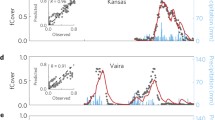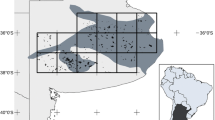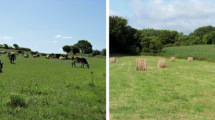Abstract
We analyzed data sets on phytomass production, basal cover, and monthly precipitation of a semiarid grassland in South Africa for good, medium, and poor rangeland condition (a) to investigate whether phytomass production per unit of basal cover differed among rangeland conditions, (b) to quantify the time scales of a carryover effect from production in previous months, and (c) to construct predictive models for monthly phytomass. Finally, we applied the best models to a 73-year data set of monthly precipitation data to study the long-term variability of grassland production. Our results showed that mean phytomass production per unit of basal cover did not vary significantly among the rangeland conditions—that is, vegetated patches in degraded grassland have approximately the same production as vegetated patches in grassland in good condition. Consequently, the stark decline in production with increasing degradation is a first-order effect of reduced basal area. Current-year precipitation accounted for 64%, 62%, and 36% of the interannual variation in phytomass production for good, medium, and poor condition, respectively. We found that 61%, 68%, and 33%, respectively, of the unexplained variation is related to a memory index that combines mean monthly temperature and a memory of past precipitations. We found a carryover effect in production from the previous 4 years for grassland in good condition and from the previous 1 or 3S month for grassland in medium and poor condition. The memory effect amplified the response of production to changes in precipitation due to alternation of prolonged periods of dry or wet years/months at the time scale of the memory. The interannual variability in phytomass production per unit basal cover (coefficient of variation [CV] = 0.42–0.50 for our 73-year prediction, CV = 0.57–0.71 for the 19-year data) was greater than the corresponding temporal variability in seasonal rainfall (CV = 0.29).






Similar content being viewed by others
References
JPH Acocks (1953) Veld types of South Africa. 3rd ed. Memoirs of the Botanical Survey of South Africa, No. 28. . .
MR Aguiar OE Sala (1999) ArticleTitlePatch structure, dynamics and implications for the functioning of arid ecosystems. Trends Ecol Evol 14 273–7 Occurrence Handle10.1016/S0169-5347(99)01612-2 Occurrence Handle10370263
JE Anderson RS Inouye (2001) ArticleTitleLandscape-scale changes in plant species abundance and biodiversity of a sagebrush steppe over 45 years. Ecol Monogr 71 531–56
TH Arnold BC De Wet (1993) Plants of Southern Africa: names and distribution. Memoirs of the Botanical Survey of South Africa, No. 62. . .
FS Chapin (1991) Effects of multiple environmental stresses on nutrient availability and use. HA Mooney WE Winner EJ Pell (Eds) Responses of plants to multiple stresses. Academic Press San Diego (CA) 67–88
EK Christie (1981) ArticleTitleBiomass and nutrient dynamics in a C4 semi-arid Australian grassland community. J Appl Ecol 18 907–18 Occurrence Handle1:CAS:528:DyaK3sXktVChu7w%3D Occurrence Handle8499477
JE Danckwerts LO Nel (1989) ArticleTitleThe effect of frequency of defoliation on Themeda triandra in the false thornfeld of the Eastern Cape. J Grassland Soc S Afr 6 32–6
Preez CC Du HA Snyman (1993) ArticleTitleOrganic matter content of a soil in a semi-arid climate with three long-standing veld conditions. Afr J Rangeland Forage Sci 10 108–10
JR Ehleringer O Bjorkman (1977) ArticleTitleQuantum yields for CO2 uptake in C3 and C4 plants: dependence on temperature, CO2, and O2 concentrations. Plant Physiol 59 86–90 Occurrence Handle1:CAS:528:DyaE2sXhtFOktLc%3D
HE Epstein WK Lauenroth IC Burke (1997) ArticleTitleEffects of temperature and soil texture on ANPP in the U.S. Great Plains. Ecology 78 2628–31
L Fahrig (1997) ArticleTitleRelative effects of habitat loss and fragmentation on population extinction. J Wildlife Manag 61 603–10
L Fahrig (2002) ArticleTitleEffect of habitat fragmentation on the extinction threshold: a synthesis. Ecol Appl 12 346–53
RJ Fernández OE Sala RA Golluscio (1991) ArticleTitleWoody and herbaceous aboveground production of a Patagonian steppe. J Range Manage 44 434–7
CH Flather M Bevers (2002) ArticleTitlePatchy reaction-diffusion and population abundance: the relative importance of habitat amount and arrangement. Am Nat 159 40–56 Occurrence Handle10.1086/324120
RP Gibbens RF Beck (1988) ArticleTitleChanges in grass basal area and forb densities over a 64-year period on grassland types of the Jornada Experimental Range. J Range Manage 41 186–92
SN Goward SD Prince (1995) ArticleTitleTransient effects of climate on vegetation dynamics: satellite observations. J Biogeog 22 549–63
CJ Hanson JR Wright S Smoliak (1982) ArticleTitleUse of historic yield data to forecast range herbage production. J Range Manage 35 614–6
MT Hoffman A Ashwell (2001) Nature divided: land degradation in South Africa. UCT Press Cape Town
E Jobbagy OE Sala (2000) ArticleTitleControls of grass and shrub aboveground production in the Patagonian steppe. Ecol Appl 10 541–9 Occurrence Handle1:CAS:528:DC%2BD3MXlsVGisLs%3D Occurrence Handle11451998
EG Jobbagy OE Sala JM Paruelo (2002) ArticleTitlePatterns and controls of primary production in the Patagonian steppe: a remote sensing approach. Ecology 83 307–19
P Kareiva U Wennergren (1995) ArticleTitleConnecting landscape patterns to ecosystem and population processes. Nature 373 299–302 Occurrence Handle10.1038/373299a0 Occurrence Handle1:CAS:528:DyaK2MXjtlygtLc%3D
AK Knapp MD Smith (2001) ArticleTitleVariation among biomes in temporal dynamics of aboveground primary production. Science 291 481–4 Occurrence Handle1:CAS:528:DC%2BD3MXlslensg%3D%3D Occurrence Handle11161201
WK Lauenroth (1979) Grasslands primary production: North American grasslands in perspective. NR French (Eds) Perspectives in grassland ecology. Ecological Studies. Springer-Verlag New York 3–24
WK Lauenroth OE Sala (1992) ArticleTitleLong-term forage production of North American shortgrass steppe. Ecol Appl 2 397–403
Houèrou HN Le RL Bingham W Skerbek (1988) ArticleTitleRelationship between the variability of primary production and the variability of annual precipitation in world arid lands. J Arid Environ 15 1–18
EB Levy EA Madden (1933) ArticleTitleThe point method of pasture analysis. NZ J Agric 46 267–27
SJ McNaughton (1985) ArticleTitleEcology of a grazing ecosystem: the Serengeti. Ecol Monogr 55 259–94
SJ McNaughton M Oesterheld DA Frank KJ Williams (1989) ArticleTitleEcosystem-level patterns of primary productivity and herbivory in terrestrial habitats. Nature 341 142–4 Occurrence Handle10.1038/341142a0 Occurrence Handle1:STN:280:BiaA1cvos1E%3D Occurrence Handle2779651
SJ McNaughton OE Sala M Oesterheld (1993) Comparative ecology of African and South American arid to subhumid ecosystems. P Goldblatt (Eds) Biological relationships between Africa and South America. Yale University Press New Haven (CT) 548–67
DG Milchunas WK Lauenroth (1993) ArticleTitleQuantitative effects of grazing on vegetation and soils over a global range of environments. Ecol Monogr 63 327–66
HA Mooney (1991) ArticleTitleBiological responses to global change: an agenda for research. Ecol Appl 1 112–7
JWC Mostert (1958) Studies of the vegetation of parts of the Bloemfontein and Brandfort districts. Memoirs of the Botanical Survey of South Africa, No. 31: . . 311–226
IR Noble (1977) ArticleTitleLong-term biomass dynamics in an arid chenopod shrub community at Koonamore, South Australia. Aust J Bot 25 639–53
I Noy Meir (1973) ArticleTitleDesert ecosystems: environment and producers. Annu Rev Ecol Syst 4 25–41 Occurrence Handle10.1146/annurev.es.04.110173.000325
TG O’Connor (1994) ArticleTitleComposition and population responses of an African savanna grassland to rainfall and grazing. J Appl Ecol 31 155–71
TG O’Connor PW Roux (1995) ArticleTitleVegetation changes (1949–71) in a semi-arid, grassy dwarf shrubland in the Karoo, South Africa: influence of rainfall variability and grazing by sheep. J Appl Ecol 32 612–26
TG O’Connor GJ Bredenkamp (1997) Grassland. R Cowling D Richardson S Pierce (Eds) Vegetation of Southern Africa. Cambridge University Press Cambridge (UK) 215–57
TG O’Connor LM Haines HA Snyman (2001) ArticleTitleInfluence of precipitation and species composition on phytomass of a semi-arid African grassland. J Ecol 89 850–61 Occurrence Handle10.1046/j.0022-0477.2001.00605.x
M Oesterheld SJ McNaughton (2000) Herbivory in terrestrial ecosystems. OE Sala RB Jackson HA Mooney R Howarth (Eds) Methods in ecosystem science. Springer-Verlag New York 151–7
M Oesterheld OE Sala SJ McNaughton (1992) ArticleTitleEffect of animal husbandry on herbivore-carrying capacity at a regional scale. Nature 356 234–6 Occurrence Handle1:STN:280:By2B3cvit1w%3D Occurrence Handle1552941
M Oesterheld J Loreti M Semmartin OE Sala (2001) ArticleTitleInter-annual variation in primary production of a semi-arid grassland related to previous-year production. J Veget Sci 12 137–42
JM Paruelo E Jobbagy OE Sala W Lauenroth IC Burke (1998) ArticleTitleFunctional and structural convergence of temperate grassland and shrubland ecosystems. Ecol Appl 8 194–206
JM Paruelo WK Lauenroth IC Burke OE Sala (1999) ArticleTitleGrassland precipitation use efficiency across a resource gradient. Ecosystems 2 64–9 Occurrence Handle10.1007/s100219900058
JM Paruelo M Oesterheld CM Di Bella M Arzadum J Lafontaine M Cahuepe CM Rebella (2000) ArticleTitleA calibration to estimate primary production of subhumid rangelands from remotely sensed data. Appl Veget Sci 3 189–95
Paulsen HA Jr, Ares FN. 1962. Grazing values and management of black-grama and tobosa grasslands and associated shrub ranges of the Southwest. Technical Bulletin No. 1270. Washington (DC): US Department of Agriculture
JF Reynolds RA Virginia PR Kemp AG DeSoyza DC Tremmel (1999) ArticleTitleImpact of simulated drought on resource islands of shrubs in the Chihuahuan desert: effects of species, season, and degree of island development. Ecol Monogr 63 69–106
OE Sala ME Biondini WK Lauenroth (1988b) ArticleTitleBias in estimates of primary production: an analytical solution. Ecol Model 44 43–55 Occurrence Handle10.1016/0304-3800(88)90081-6
OE Sala WJ Parton LA Joyce WK Lauenroth (1988a) ArticleTitlePrimary production of the central grassland region of the United States. Ecology 69 40–5
ER Schulze (1979) Climate of South Africa. Part 8. General Survey. Weather Bureau Pretoria
S Smoliak (1986) ArticleTitleInfluence of climatic conditions on production of Stipa-Bonteloua prairie over a 50-year period. J Range Manag 39 100–3
FA Sneva DN Hyder (1962) ArticleTitleEstimating herbage production on semi-arid ranges in the Intermountain Region. J Range Manage 15 88–93
HA Snyman (1994) ArticleTitleEvapotranspiration, water-use efficiency and quality of six dryland planted pasture species and natural vegetation, in a semi-arid rangeland. Afr J Rangeland Forage Sci 11 82–8
HA Snyman (1998) ArticleTitleDynamics and sustainable utilization of rangeland ecosystems in arid and semi-arid climates of southern Africa. J Arid Environ 39 645–66 Occurrence Handle10.1006/jare.1998.0387
HA Snyman (2000) ArticleTitleSoil-water utilisation and sustainability in a semi-arid grassland. Water SA 26 333–41
HA Snyman HJ Fouché (1991) ArticleTitleProduction and water-use efficiency of semi-arid grasslands of South Africa as affected by veld condition and rainfall. Water SA 17 263–8
HA Snyman HJ Fouché (1993) ArticleTitleEstimating seasonal herbage production of a semi- arid grassland based on veld condition, rainfall and evapotranspiration. Afr J Rangeland Forage Sci 10 124–30
InstitutionalAuthorNameSoil Classification Working Group (1991) Soil classification: a Taxonomic system for South Africa. Department of Agriculture Development Pretoria
B Van den Berg BR Roberts LF Vorster (1975) ArticleTitleThe effect of seasonal grazing on the cover and composition of Cymbopogon-Themeda veld. Proc Grassland Soc S Afr 10 111–7
SR Veron JM Paruelo OE Sala WK Lauenroth (2002) ArticleTitleEnvironmental controls of primary production in the Argentine pampas. Ecosystems 5 625–35
WH Whitford (1995) Desertification: implications and limitations of the ecosystem health metaphor. DJ Rapport CL Gaudet P Calow (Eds) Evaluating and monitoring the health of large-scale ecosystems. Springer-Verlag New York 273–93
Acknowledgements
Funding provided by the UFZ Center of Environmental Research, Leipzig, Germany, and the Department of Plant and Soil Sciences of the Potchefstroom University for CHE enabled T.W. and K.K. to travel between Germany and South Africa. Funding by the International Bureau of the BMBF (ARG 012/98 ENV) and ANTORCHAS-DAAD enabled T.W. and J.M.P. to travel between Germany and Argentine for cooperative work. Two anonymous reviewers provided critical and thorough comments that markedly improved the content of this manuscript.
Author information
Authors and Affiliations
Corresponding author
Rights and permissions
About this article
Cite this article
Wiegand, T., Snyman, H., Kellner, K. et al. Do Grasslands Have a Memory: Modeling Phytomass Production of a Semiarid South African Grassland . Ecosystems 7, 243–258 (2004). https://doi.org/10.1007/s10021-003-0235-8
Received:
Accepted:
Published:
Issue Date:
DOI: https://doi.org/10.1007/s10021-003-0235-8




